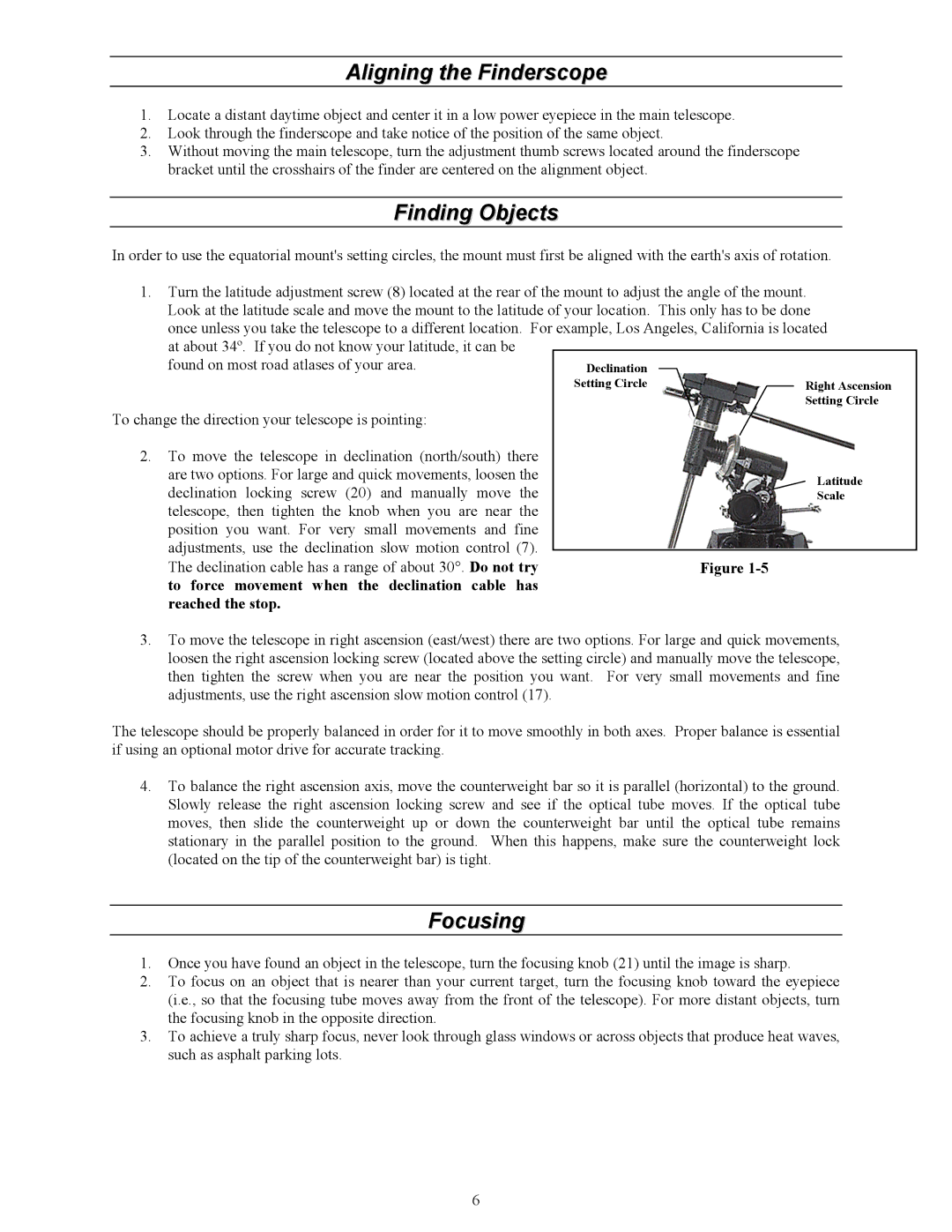
Aligning the Finderscope
1.Locate a distant daytime object and center it in a low power eyepiece in the main telescope.
2.Look through the finderscope and take notice of the position of the same object.
3.Without moving the main telescope, turn the adjustment thumb screws located around the finderscope bracket until the crosshairs of the finder are centered on the alignment object.
Finding Objects
In order to use the equatorial mount's setting circles, the mount must first be aligned with the earth's axis of rotation.
1.Turn the latitude adjustment screw (8) located at the rear of the mount to adjust the angle of the mount. Look at the latitude scale and move the mount to the latitude of your location. This only has to be done once unless you take the telescope to a different location. For example, Los Angeles, California is located at about 34º. If you do not know your latitude, it can be
found on most road atlases of your area. |
| Declination |
|
|
|
|
|
|
|
|
|
|
| ||
|
| Setting Circle |
| Right Ascension |
| ||
To change the direction your telescope is pointing: |
|
|
| Setting Circle |
| ||
|
| ||||||
|
|
|
|
|
|
| |
|
|
|
|
|
|
| |
2. To move the telescope in declination (north/south) there |
|
|
|
|
|
|
|
are two options. For large and quick movements, loosen the |
|
|
|
| Latitude |
| |
declination locking screw (20) and manually move the |
|
|
|
| Scale |
| |
telescope, then tighten the knob when you are near the |
|
|
|
|
|
|
|
|
|
|
|
|
|
| |
position you want. For very small movements and fine |
|
|
|
|
|
|
|
adjustments, use the declination slow motion control (7). |
|
|
|
|
|
|
|
|
|
|
|
|
|
| |
The declination cable has a range of about 30°. Do not try |
|
| Figure | ||||
to force movement when the declination cable has |
|
|
|
|
|
|
|
reached the stop. |
|
|
|
|
|
|
|
3.To move the telescope in right ascension (east/west) there are two options. For large and quick movements, loosen the right ascension locking screw (located above the setting circle) and manually move the telescope, then tighten the screw when you are near the position you want. For very small movements and fine adjustments, use the right ascension slow motion control (17).
The telescope should be properly balanced in order for it to move smoothly in both axes. Proper balance is essential if using an optional motor drive for accurate tracking.
4.To balance the right ascension axis, move the counterweight bar so it is parallel (horizontal) to the ground. Slowly release the right ascension locking screw and see if the optical tube moves. If the optical tube moves, then slide the counterweight up or down the counterweight bar until the optical tube remains stationary in the parallel position to the ground. When this happens, make sure the counterweight lock (located on the tip of the counterweight bar) is tight.
Focusing
1.Once you have found an object in the telescope, turn the focusing knob (21) until the image is sharp.
2.To focus on an object that is nearer than your current target, turn the focusing knob toward the eyepiece (i.e., so that the focusing tube moves away from the front of the telescope). For more distant objects, turn the focusing knob in the opposite direction.
3.To achieve a truly sharp focus, never look through glass windows or across objects that produce heat waves, such as asphalt parking lots.
6
